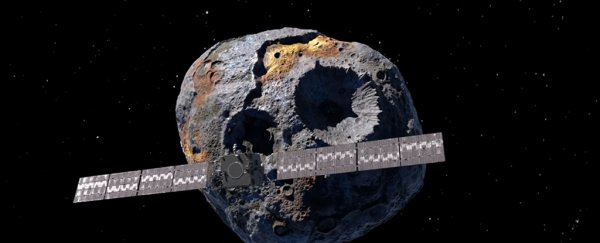NASA has green-lit a plan to send a probe to a strange metal asteroid called 16 Psyche, which experts think could be the core of an ancient planet, stripped bare of its original surface and outer crust.
16 Psyche, which sits in the asteroid belt between Mars and Jupiter, is unlike anything else in our Solar System, and that means it could have plenty to reveal to researchers about how the earliest planets orbiting the Sun formed.
A team from Arizona State University led by planetary scientist Lindy Elkins-Tanton proposed the mission in 2015, and now it's been confirmed by NASA – meaning the Psyche probe could be on its way into space as early as 2023.
"This is an opportunity to explore a new type of world – not one of rock or ice, but of metal," says Elkins-Tanton. "16 Psyche is the only known object of its kind in the solar system, and this is the only way humans will ever visit a core. We learn about inner space by visiting outer space."
In other words, the mission could help tell us what Earth's core is like, without the need to drill down thousands of kilometres into our own planet.
We've known about 16 Psyche since 1852, but this is the first opportunity where we'll get a close look at it. Measuring more than 200 kilometres (124 miles) in diameter, indications are that it's mostly made up of iron and nickel.
Scientists think 16 Psyche could've once been a planet the size of Mars, but that a series of violent collisions with other objects in the Solar System whittled it down to just its core.
What's more, it could've been around in the very earliest days of the Solar System, just 10 million years after the birth of the Sun, and so could hold clues about how the planets evolved and formed their layers more than four billion years ago.
After zooming past Mars, the uncrewed Psyche probe should reach the metal asteroid that it shares a name with by 2030. From there it will spend 20 months in orbit, taking snaps of 16 Psyche, and measuring its composition, plus the strength and gravity of its magnetic field.
Part of what makes the Psyche mission so exciting is that we know so little about the asteroid right now. Just last year, observations from the NASA Infrared Telescope suggested that water or hydroxyl could be present on the surface of 16 Psyche, something the probe should be able to confirm.
And it's not the only mission NASA has just approved as part of its Discovery Program, funding lower-cost explorations of the Solar System: another mission, called Lucy, will visit six Trojan asteroids – space rocks caught in Jupiter's gravitational pull.
As with Psyche, the aim is to learn more about the early days of our Solar System and the way it was formed. Lucy is going to launch first, setting off in 2021, and should reach its first destination in 2025.
"This is what Discovery Program missions are all about," says NASA's Thomas Zurbuchen. "Boldly going to places we've never been to enable groundbreaking science."

